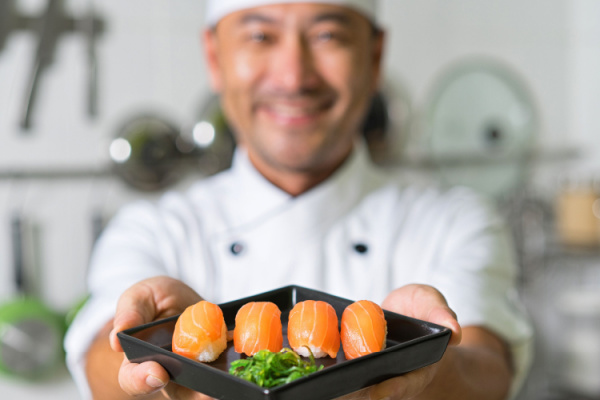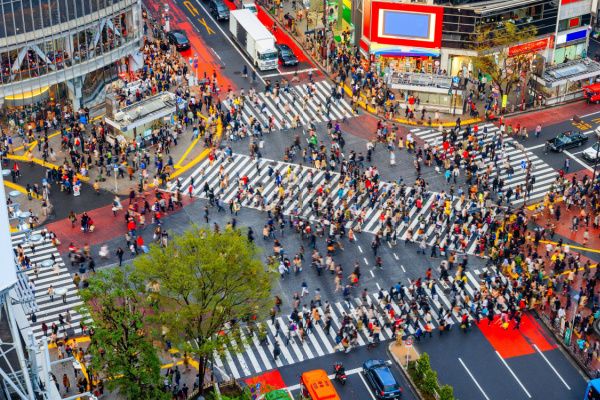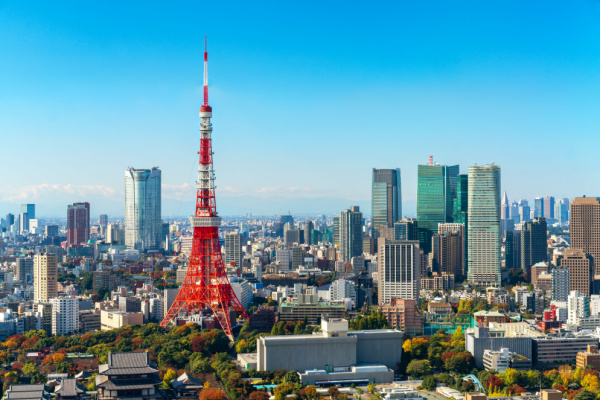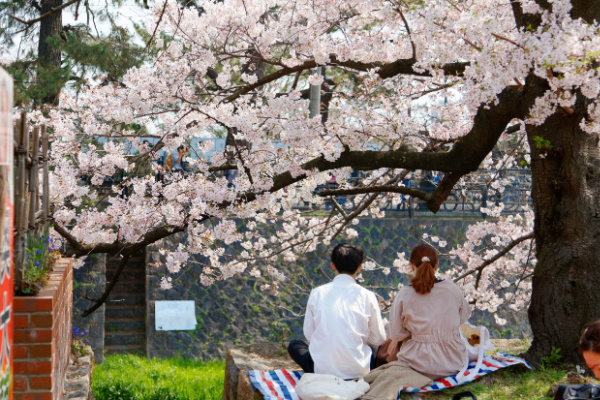Tan lines are beginning to fade, your eReader is gathering dust, and that blissful slower pace or sense of adventure that comes with holidaying has been whisked away and replaced with the dreaded post-holiday blues. But before you succumb to its melancholy, we’ve got a tried and tested remedy to pull you out of the doldrums – it’s time to start planning your next holiday!
In this guide, we’re casting the spotlight on two countries we know won’t disappoint, both destinations are filled with culture, adventure and plenty to see and do, and although they may not make the Top 10 Most Popular with Tourists list Japan and Korea are 100% worthy of your holiday bucket list! And what better time to jet off than March and April when the cherry blossoms are blooming, both countries light up with festivals, hot spring excursions and peak tourist season is yet to kick off. So, let’s get planning.
Must visit – Japan
Japan is a country of contrast; ancient traditions and temples sit alongside neon-lit bustling centres, and beautifully diverse scenery provides the backdrop to a captivating culture, culinary adventures, and, of course, its fair share of UNESCO World Heritage sites. While you’re there, we recommend:
- Taking your tastebuds on tour in Tokyo
Known as the eating capital of Japan with 230 Michelin-star restaurants, Tokyo is your ultimate destination for a culinary crawl. There are plenty of ‘must-eat’ foods– from Sushi, Tempura, Yakitori, and Soba – and you’ll find these all available for various budgets. We recommend hitting Tokyo’s Tsukiji Outer Market, or ‘food town,’ and drinking the latest culinary trends alongside traditional Japanese foods. You’ll also find the freshest sashimi in town and have the opportunity to stock up on unique utensils and kitchenware while you’re there.

- Experiencing an assault to the senses at Shibuya and Dotonbori
While you’ve seen it in countless movies, magazines, and TV shows, nothing compares to visiting Shibuya Crossing and seeing it yourself. This sprawling, iconic intersection promises action from all directions and at all times of the day or night. There are crowds, larger-than-life video screens, and sounds and smells to awaken all your senses. If you’re in Osaka, head to Dotonbori for a similar (albeit more low-key) experience. You’ll find a sensory carnival of lights, sounds, and flavours, the iconic Glico Running Man sign, electric nightlife, and plenty of riverside dining and drinking spots.

- Getting grounded with temples and tea
If you’re going to tick just one temple off your list, make it Senso-ji – Japan’s longest-standing temple steeped in over 1300 years of history. Located in the Asakusa district – just a 15-minute train ride from Tokyo station – it’s the most frequented spiritual site in the world and well worth a visit. Another temple stop we recommend is Kyoto’s Kinkakuji or Golden Pavillion; set among meticulously manicured gardens, the top two gold leaf-covered floors reflecting in the mirror-like waters it hovers above are a sight to behold.
Once you’re feeling grounded, take tea in Tokyo (or beyond) for a taste of one of Japan’s most ancient rituals and most popular cultural experiences. Sip on the best matcha, wear a kimono, and get transported to a more tranquil state of mind amid the sometimes chaotic backdrop.
- Getting your thrills at Universal Studios
Universal Studios Japan in Osaka has it all – the wizarding world of Harry Potter, a terrifying Jaws boat ride, sedate Sesame Street movie magic, heart-pounding roller coasters, and so much more. Set aside a day (at least) and enjoy a perfect blend of entertainment and excitement for the young and young at heart.
- Taking in towers and towering volcanoes
With 360-degree views of the city, the Tokyo Tower is the second tallest in Japan and comes complete with restaurants, museums, and shops alongside two observation decks. Modelled after a famous European cousin (The Eiffel Tower), Tokyo has notched up more than 150 million visitors since its construction, making it one of Tokyo’s most visited attractions. And if tall things are your cup of matcha, Mount Fuji – Japan’s highest mountain – towering a majestic 3776 metres on the border between Yamanashi and Shizuoka prefectures should be your next stop. This perfectly cone-shaped active volcano is surrounded by pristine lakes and lush landscapes and is revered as a sacred spiritual place by the Japanese.

- Picnicking under the blossoms
From March to early May, Tokyo’s parks are transformed with a sea of delicate pink petals (known as Sakura). Visit one of the best cherry blossom viewing spots in Tokyo, pack a picnic (we suggest a bento and an Asahi), and get involved in Hanami – which translates to “flower viewing.” This spectacle isn’t just limited to Tokyo – plenty is going on in Kyoto, Osaka, Nagoya, and beyond.

- Shopping delights with a difference
Japan is full of world-class and unique shopping experiences, and if you’re just stopping in Tokyo, we recommend a wander through Akihabara Electric Town. This shopping hub is affectionately known as ‘geek town,’ but you don’t have to be one to have a good time here! It has the highest concentration of manga, anime merchandise, electronic shops, and arcades that you’ll find anywhere in the world. For the latest in fresh Japanese fashion, head to Harajuku. Here, you’ll find designer shops, upscale boutiques, counterculture stores, and cafes – it also makes a great people-watching destination.
- Making like Mario and Go Karting around
Double-decker tour buses, busy trains, and taxis are so passé. Have you ever toured a city by go-kart? Now’s your chance! While it does take a little bit of planning (ensuring you have the correct driver's license and booking online well in advance), it’s well worth it when you're hitting the tarmac and screeching (sensibly) through the city on an organised go-kart tour of Tokyo.
How to travel Japan like a pro
Before you go, make sure you’ve got these Japan travel hacks sorted:
- Add Suica to your Apple wallet – Suica not only to access Japan’s phenomenal train network but can be used in convenience stores, too. It’s easy to top up on your phone and an essential Japan travel accessory.
- Get to know Konbini – eating in convenience stores is big in Japan (and convenient!), and plenty of Konbini hacks might sound weird, but just work. Spicy fried chicken in maple butter pancakes or curry ramen cup with mochi, anyone? Check out TikTok or Instagram for some unusual combinations to try. If you dare!
- Learn some local etiquette – from not speaking while on public transport to eating on the go and shoes off protocol, take some time to learn some key do’s and don’ts of Japanese etiquette.
- Go beyond Konnichiwa – while English is spoken in most major tourist areas, locals appreciate visitors who give their local language a go.
Hop skip to Korea
Just a hop skip and a couple of hours on a plane from Japan, you’ll land in Korea – known to its people as Chosun – often translated as the land of the morning calm. For visitors, Korea offers a mesmerising mix of K-pop culture, rich history, stunning coastlines, and mountain ranges, plus plenty of food, glorious food. Here’s how to spend your time:
- Getting cultural
You haven’t visited Korea until you’ve soaked up some local culture. We recommend heading to Busan to take in some landmark temples and the Gamcheon Culture Village. While historic temples are dotted all over Korea, the Beomeosa Temple is our pick. To soak up the full experience, you can stay for a day (or even overnight) and get a real taste of Buddhist monastic life. You’ll be involved in meditation tea ceremonies and dine on traditional monastic meals in what has been described as an experience of a lifetime.
For more of a visual experience, head to Gamcheon Culture Village, drink in colourful houses stacked on the mountainside, and walk the narrow alleys that weave in a twisted labyrinth. The village was initially built in the 1950s by Korean War refugees but renovated in 2009 in collaboration with local artists.

- Soaking up dynasties past
Built in 1405, the UNESCO World Heritage site Changdeokgung Palace in Seoul is the most well-preserved of the five royal palaces in South Korea. Sitting at the foot of Unbong Peak, it’s a picturesque backdrop for intricate stone carvings, a secret garden, countless historic courtyards, and a rich tapestry of stories to be told. We recommend a guided tour to immerse yourself in the experience fully.
- Taking a dip in nature
From caves to peaks and national parks, Korea has a lot going on for nature lovers. Topping our list is Jeju Island. Jeju is just an hour's flight from Seoul, but you’ll feel more than a world away from South Korea's capital's bright lights and bustling streets. It’s home to lush forests, pristine beaches, Hallasan National Park, and plenty of waterfalls to chase. And while you’re in Jeju, be sure to visit the Manjanggul Lava Tube – one of the largest in the world at over 7,000 meters long and up to 25 meters high! While most of the cave is closed off to protect its value to science and conservation studies, you can enter a section where you’ll see the world's tallest (known) lava column and plenty of impressive stalactites and stalagmites.

- Towering above Seoul
Seoul Tower (also known as Namsan Tower) is so much more than a tall building. Set amongst popular hiking spot Namsan Park, you can picnic, stroll, eat, add a love-lock to the foot of the tower, or simply take in the spectacular views from the top observation deck. Seoul Tower is equally stunning at dusk when sunshine gives way to a sea of twinkling city lights.
- Shopping ‘til you drop
From fresh fish to fashion finds, shopping features highly on Korea’s highlights list. In Seoul, we recommend heading to Myeongdong Shopping Street –a car-free zone filled with everything from global brands you’ll know at home to Korean fashion brands, Korean cosmetics, and must-try street food like Bibimbap and Kimchi. Further afield in Busan (on the southern coast), visit South Korea’s largest fish market – Jagalchi Fish Market. Selling live, fresh, and dried fish, you can purchase live seafood on the ground floor and take it to a restaurant on the second floor for preparation and cooking – it doesn’t get fresher than that!
How to travel Korea like a pro
From weather to finding your way around, take in these tips for a seamless travel experience:
- Watch the weather – weather in Korea can fluctuate wildly. It’s not unusual to experience 20 degrees one day and 5 degrees the next. Be prepared with plenty of layers of clothing.
- Say ‘annyeong’ to Google Maps – annyeong means goodbye (or hi), and that’s what you’ll be saying to your old trusty Google Maps, as it doesn’t work in Korea. Download a locally available app like Naver or Kakao to find your way around.
- Dress like a local, get perks – entrance to some palaces like Gyeongbokgung and Changdeokgung is free if you’re wearing Hanbok (traditional Korean clothing).
- Learn some local phrases and customs – while English is spoken in most major tourist areas, get on board with the experience and learn a few key phrases. Also, make sure you’re familiar with local customs like bowing, removing shoes, and receiving any objects with both hands.
Banish the blues and get planning
From tranquil tea ceremonies to bustling shopping and nightlife, Korea and Japan offer visitors the opportunity to experience a unique fusion of history, culture, and technology unlike anything else. To experience the very best of it, remember to check for any travel restrictions or entry requirements, book your accommodation well in advance, keep an eye on any festivals happening while you’re there, and most of all, take the time to soak up all the weird and wonderful tastes, sights, sounds and smells of Asia.
DISCLAIMER
The following advice is of a general nature only and intended as a broad guide. The advice should not be regarded as legal, financial, or real estate advice. You should make your own inquiries and obtain independent professional advice tailored to your specific circumstances before making any legal, financial, or real estate decisions. Click here for full Terms of Use.

